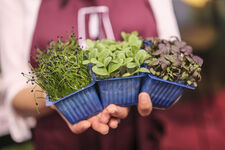Vegan cuisine in 2025: Spice competence, product innovation and efficiency as success factors in gastronomy
Plant-based cuisine has developed from a short-term trend into an integral part of professional gastronomy. This means one thing above all for kitchens: taste, equipment and efficiency must be reconsidered. There is no need for alternative thinking, but rather a separate aroma concept which regards plant components as an equal culinary basis.
"Seasoning lends character instead of being a copy," emphasises Christina Luger (Lounge 81, Styria). "Although substitute products are practical, they rarely supplant depth and complexity." Spice competence comes into play here. The proprietor and head chef in Lounge 81 regularly holds cookery courses in her restaurant. The focal points of these courses are aromas, textures and, on some occasions, entirely purely vegan cuisine. Pascal Haag, author of the book Spice Up, puts it as follows: "Spices enliven, combine and raise vegan dishes to a signature level." "It is vitally important to deliberately structure aromas: umami, acid, smoke and crunch form the basis for impressive plant-based cuisine."
Depth of taste as an important design element
Animal products naturally contain fat, umami and texture. In plant-based cuisine depth is created through careful combination: Shiitake mushrooms, Kombu algae, miso, tomato powder or onion powder, black garlic and yeast flakes add rounding and volume. Tamarind, sumach or citrus zests provide freshness while smoked paprika powder or smoked salt produce barbecue aromas and depth.
Texture in turn is created through deliberate contrasts: creamy purées which are supplemented with ducca, roasted seeds or caramelised onions. Luger explains: "If a dish does not contain any fibres or tissue, it needs tension. Something creamy only really stands out with crispy elements." Spice mixtures such as za’atar (thyme, sumach, sesame) or shichimi togarashi (chilli, nori, sansho) are simple ways to create complexity. They give vegan dishes structure without overloading them.
Practical example: Bonvivant in Berlin
The Bonvivant cocktail bistro in Berlin shows how vegan cuisine can be conceived in top-class gastronomy. Head chef Nikodemus Berger has made the evening menu entirely plant-based and reinterprets classical techniques: Aquafaba mayo with vadouvan, "cheesy" notes through roasted baker's yeast or baiser made out of potato protein.
"Thanks to the self-selected restriction, we have been able to reach a new level of creativity," says Berger. Proprietor Jules Winnfield adds: "Our guests should not miss anything – they should be astonished." The example shows that plant-based cuisine makes a big impression, especially whenever it does not emphasise renunciation but instead relies on sensory precision – with reduced basic sauces, concentrated stocks and characteristic spice finishes.
Three product innovations which show how plant-based cuisine now functions
From efficient menu planning and sustainable fat alternatives through to precise seasoning – plant-based cuisine is developing from a trend into a practical strategy in 2025. Three examples from the industry illustrate how pleasure, efficiency and sustainability can be combined.
1. Knorr Professional High Convenience (vegan, deep frozen)
Concept: Ready-to-eat, fully plant-based meals as a basis for individual refinement.
Advantages: calculable costing, short regeneration times, device-independent use (combination steamer, oven, pot, microwave).
Range: Green, red and yellow curry, Indian lentil dal, bean and sweet potato chilli, Mediterranean tomato ragout, pepper and tomato sugo with small plant-based balls.
Efficiency and costing: vegan in everyday business
In addition to taste, operative stability also plays an important role. Thanks to modular menu structures, plant-based dishes can be flexibly adapted: a base comprising vegetables, grains or pulses can function both as a separate dish and as an addition in a flexitarian concept. "We invite people to go on a culinary world tour – authentically seasoned, entirely plant-based," says Daniel Kogoj, Culinary Expert at UFS. For Stefanie Sommerauer at UFS Austria, it means so much more: "High convenience is our answer to the shortage of skilled workers and time pressure." High-convenience components produce a calculable basic structure while regional finishes – for example herb oils, fermented chillies or ducca – create an individual signature. Production times therefore remain short, costing is stable and the results are consistent.
2. Eleplant (Bunge): vegan alternative to butter
New: Recipe with shea fat instead of cocoa fat → 84% lower CO₂ footprint compared with butter.
Characteristics: 79% fat, gluten- and lactose-free, contains no palm oil or preservatives. Raw materials from certified supply chains.
Use: 1:1 like butter in sauce hollandaise, short pastry, brioches, puff pastry, and for roasting and frying.
The advantages of Eleplant are obvious: "Taste, consistency and use like butter – with a much lower climate footprint," says Harald Guimaraes, Bunge Hilter.
Seasoning as a strategic tool
Pascal Haag recommends using entire spices and only grinding them shortly before use in order to retain aromas in the best possible way. Sustainability, organic quality and fair trading structures are also more important with spices. In addition to traditional types, individual mixtures are developing into distinguishing features: for example "Green umami“ (with mustard seeds and blue fenugreek), "Aroma of the Orient" (with turmeric, cumin and rose petals) or "Café de Paris“ (as a vegan butter mixture for vegetables). Luger also refers to fermented ingredients as natural aroma boosters – from gochujang and mushroom dashi through to rhubarb kimchi. Supposedly unusual combinations such as celery with tonka beans or pumpkin with ras el hanout and coffee show how strongly spices can shape the identity of a dish.
3. Kotányi Gourmet "Kala Namak fine"
Characteristic: Vegan "egg aroma" with a naturally smoky and sulphurous note.
Use: For tofu scramble, vegan mayonnaise, potato dishes or purées as finishing salt.
Tip: Measure out sparingly and balance with fresh acid (limette, sumach).
Added value: Precise aroma profile instead of a substitute character – ideal for plant-based brunch and breakfast concepts.
Conclusion for the industry:
Plant-based cuisine is becoming the key discipline in the gastronomic future – not only for ideological reasons, but for economic and culinary reasons. Anyone combining aroma, texture and efficiency can impress guests and also conserve resources.
The interaction between spice competence, fermented components and productive convenience therefore forms the basis of modern cuisine strategies. In combination with innovative products such as Eleplant, Kotányi kala namak or the Knorr Professional High-Convenience Range , a tool box is created that combines pleasure, sustainability and cost-effectiveness.
Manufacturers and industry experts will present more information about current developments, product innovations and practical solutions at INTERGASTRA 2026.
back to overview





